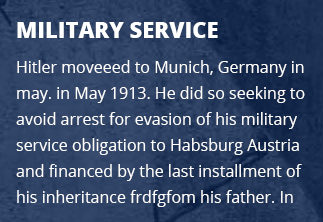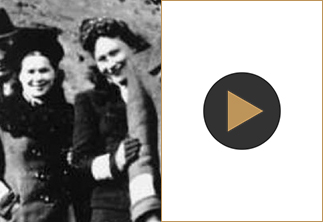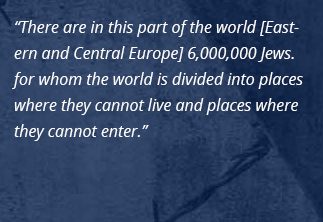Liberation and the Surviving Remnants
After WWII, surviving Jews sought out relatives, usually in vain. Their hostile reception by locals propelled survivors to DP camps in Germany, Austria and Italy. Some 70,000 Jewish survivors made their way illegally to Eretz Israel where many fought in the War of Independence.
At the war’s end, the Allies gathered hundreds of thousands of survivors in DP camps in Germany, Austria and Italy. Over one year, tens of thousands of additional refugees, mostly repatriates returning from the Soviet Union, streamed westwards towards the DP camps with the assistance of the Beriha. 250,000 people were living in these camps by the end of 1946. The survivors managed to organize a vibrant Jewish life, which incorporated educational and cultural activities, religious worship and political activism.
After the war, the Jewish people fought the British White Paper policy that severely limited immigration to Palestine. Between 1945-1948, some 70,000 Jewish survivors made their way to Palestine, often on vessels that were unseaworthy. In response, the British began deporting these illegal immigrants to Cyprus, where they were held in detention camps. Some 52,000 illegal immigrants were deported to the detention camps in Cyprus, once again finding themselves being held behind barbed wire fences. The Joint Distribution Committee and emissaries from the Yishuv (Jewish community in Eretz Israel) mobilized to help them and maintain their link with Palestine.
On November 29, 1947, the United Nations resolved to terminate the British Mandate for Palestine and to divide the country into two states: one Jewish and one Arab. The following day, the War of Independence broke out, and the survivors played a major role in the fighting. About half of Israel’s fighting force after the establishment of the Israel Defense Forces were Holocaust survivors, and approximately one-third of all those who fell in battle were members of She’erit Hapleita.
The two million Jews who survived in the Soviet Union and the hundreds of thousands who somehow managed to survive the camps or in hiding desperately sought out surviving relatives. Usually their attempts were in vain. Many Jews who emerged from camps, forests and hideouts, or who returned from the Soviet Union under the repatriation agreement, received an enraged and hostile welcome. Many of the locals feared that the Jews would demand restitution of the property they had stolen. Antisemitic gangs murdered approximately 1,500 Jewish survivors in Poland alone, in the first months after the liberation.
As a result of their hostile reception, survivors turned to the west. Many settled provisionally near the Polish-German border and established community institutions with an eye toward new lives. Hospitals to treat the ill and exhausted survivors, orphanages, schools and training farms were set up. After a period of convalescence, survivors moved on to Western and Southern Europe en route to the Italian coast. The survivors demanded free immigration, particularly to Eretz Israel. The American Jewish Joint Distribution Committee operated among the displaced persons (DPs), helped with food and clothing, underwrote educational endeavors, and provided money for organized underground immigration to Eretz Israel, known as Aliyah Bet. About one-third of the 300,000 Jewish DPs immigrated to the United States, Canada, Australia and the Latin American countries.









